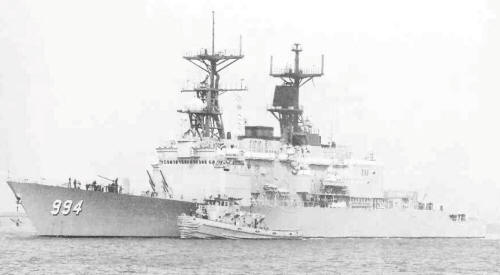
NAVYPEDIA
 Support the project with paypal
Support the project with paypal
Photo

Callaghan 1988
Ships
| No | Name | Yard No | Builder | Laid down | Launched | Comm | Fate |
|---|---|---|---|---|---|---|---|
| DDG993 | Kidd (ex-كوروش [Kouroush]) | 4601 | Ingalls SB, Pascagoula (Litton Industries) | 26.6.1978 | 11.8.1979 | 27.6.1981 | stricken 3.1998, to Taiwan (左營 [Tsoying]) |
| DDG994 | Callaghan (ex-داریوش [Daryush]) | 4602 | Ingalls SB, Pascagoula (Litton Industries) | 23.10.1978 | 1.12.1979 | 29.8.1981 | stricken 3.1998, to Taiwan (蘇澳 [Suao]) |
| DDG995 | Scott (ex-نادر [Nader]) | 4603 | Ingalls SB, Pascagoula (Litton Industries) | 12.2.1979 | 1.3.1980 | 24.10.1981 | stricken 12.1998, to Taiwan (基隆 [Keelung]) |
| DDG996 | Chandler (ex-انوشیروان [Anoushirvan]) | 4604 | Ingalls SB, Pascagoula (Litton Industries) | 7.5.1979 | 24.5.1980 | 13.3.1982 | stricken 9.1999, to Taiwan (馬公 [Makung]) |
Technical data
| Displacement standard, t | 6950 light |
|---|---|
| Displacement full, t | 9574 |
| Length, m | 161.2 wl 171.7 oa |
| Breadth, m | 16.8 |
| Draught, m | 7.01 mean 10.1 over sonar dome |
| No of shafts | 2 |
| Machinery | 4 General Electric LM-2500 gas turbines |
| Power, h. p. | 86000 |
| Max speed, kts | 31.5 |
| Fuel, t | gas turbine oil 1650 |
| Endurance, nm(kts) | 6000(20) |
| Armament | 2 x 4 Harpoon SSM (8 RGM-84), 2 x 2 Standard SM-1MR SAM / ASROC ASuR (52 RIM-66, 16 RUR-5), 2 x 1 - 127/54 Mk 45, 2 x 6 - 20/76 Mk 15 Phalanx CIWS, 2 x 3 - 324 Mk 32 TT (24), 1 2 SH-2 helicopter |
| Electronic equipment | LN-66, SPS-55, SPS-48C, 2x SPG-51D, SPQ-9A, SPG-60, 2x Mk 90 radars, SQS-53A sonar, SLQ-32(v)2 ECM suite, 4x Mk 137 decoy RL (Mk 36 SRBOC system), SLQ-25 Nixie torpedo decoy, NTDS CCS |
| Complement | 364 |
Graphics
Project history
A contract for the development and production of thirty ships was awarded on 23 June 1970 to a new established by Ingalls Shipbuilding Division of Litton Industries, Pascagoula, Mississippi. The entire class was contracted to a single shipyard to facilitate design and mass-production, but construction was delayed by labour and technical problems. These large destroyers were surely among the more controversial of recent US warships: they were usually described as too large and too poorly armed. In fact they were the direct consequence of an attempt to replace the mass of Second World War destroyers, which were nearing the end of their lives in the mid-1960s.
Initially, it was hoped that most of the ASW destroyers would be replaced by Knox class ocean escorts, and that the Navy would build a new class of missile destroyers to make up for the gap in such construction since the early 1960s, a gap caused largely by the failure of the Typhoon system planned for FY63 and later units. Analysis suggested, first, that it would be wise to seek maximum commonality between the ASW and missile units, and second, that although each carrier would require six escorts, only three would need anti-aircraft missile capability. In addition, Secretary McNamara strongly espoused a project system in which preliminary design would be done by a contractor.
One of the benefits of a common hull was that, if the air threat were to increase in the future, ASW ships could easily be refitted to meet it. Ultimately, relatively few ships could be ordered, none of them for air defence. However, the Spruance remained an anti-aircraft design with its missiles, radars and some of its computers never installed. To some extent, too, its large size was mandated by the requirement for 30kts in rough weather, a requirement of carrier operation.
Plans to install single lightweight 203mm/55 guns for amphibious fire support were cancelled in 1978, but the potential for major AA upgrade remains. Indeed, Iran ordered six (later reduced to four) anti-aircraft versions of the Spruance class in 1973-74. With the Iranian Revolution, they were offered for sale, and all four were purchased as the Kidd dass in July 1979, receiving DDG hull numbers in the Spruance series. As in the case of Virginia class cruisers, they have magazine stowage for 68 missiles, with two SPG-51D guidance radars plus an SPG-60. The greatly increased displacement of the Kidds is due in part to the addition of armour. A thirty-first Spruance, DD997, was authorised in FY78 with the proviso that it had increased helicopter facilities; however, she was identical to the 30 earlier ships already ordered, except for the provision of Kevlar armour and an SPS-49 air search radar. The Reagan Administration FY83-FY87 programme included three more ships of this type in FY86-FY87, out of a planned total of six. None was built.
Modernizations
1988, Scott; 1989, Kidd; 1990, Callaghan, Chandler: - 2 x 2 Standard SM-1MR SAM / ASROC ASuR (52 RIM-66, 16 RUR-5), SPS-48C radar; + 2 x 2 Standard SM-2MR SAM (68 RIM-66), SPS-48E, SPS-49(v)5 radars
early 1990s, all: - LN-66 radar, SLQ-32(v)2 ECM; + 4 x 1 - 12.7/90, SPS-64(v)9 radar, SLQ-32(v)5 ECM suite
Naval service
No significant events.
 HOME
HOME FIGHTING SHIPS OF THE WORLD
FIGHTING SHIPS OF THE WORLD UNITED STATES OF AMERICA
UNITED STATES OF AMERICA TORPEDO SHIPS
TORPEDO SHIPS KIDD missile destroyers (1981 - 1982)
KIDD missile destroyers (1981 - 1982)
